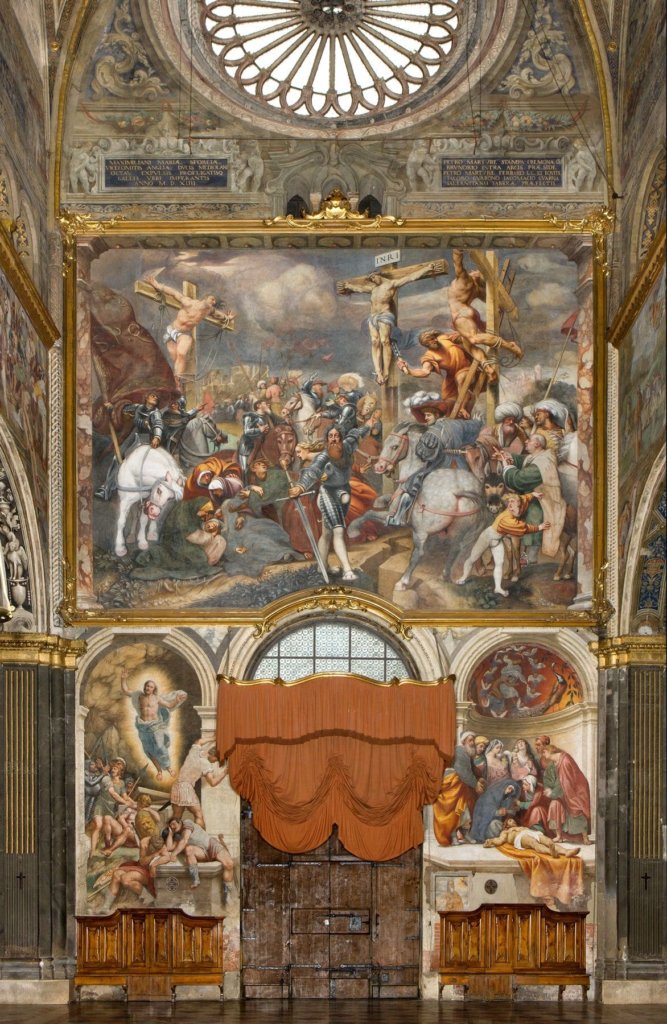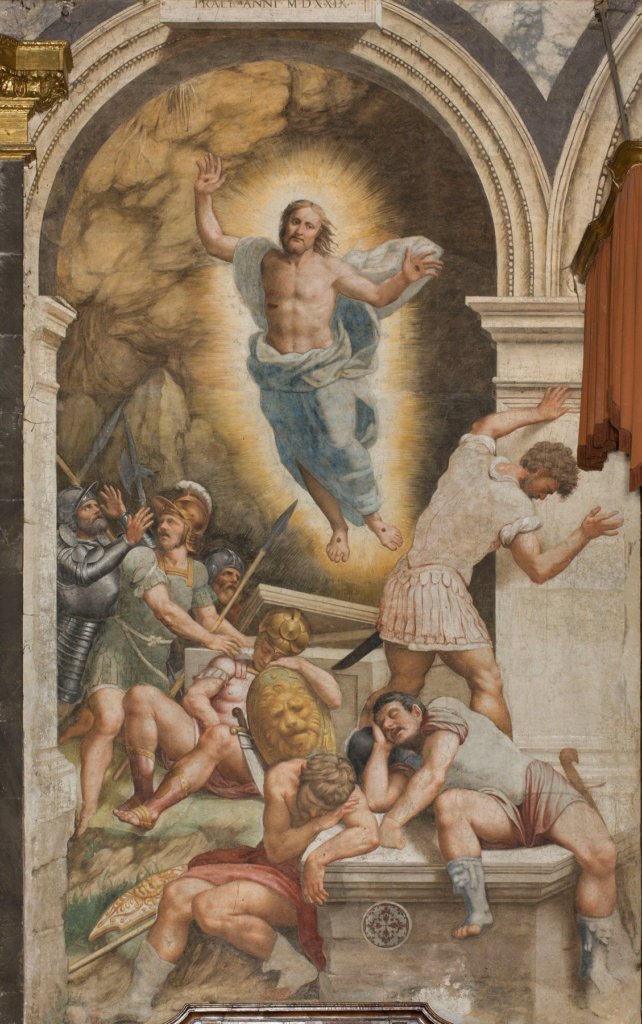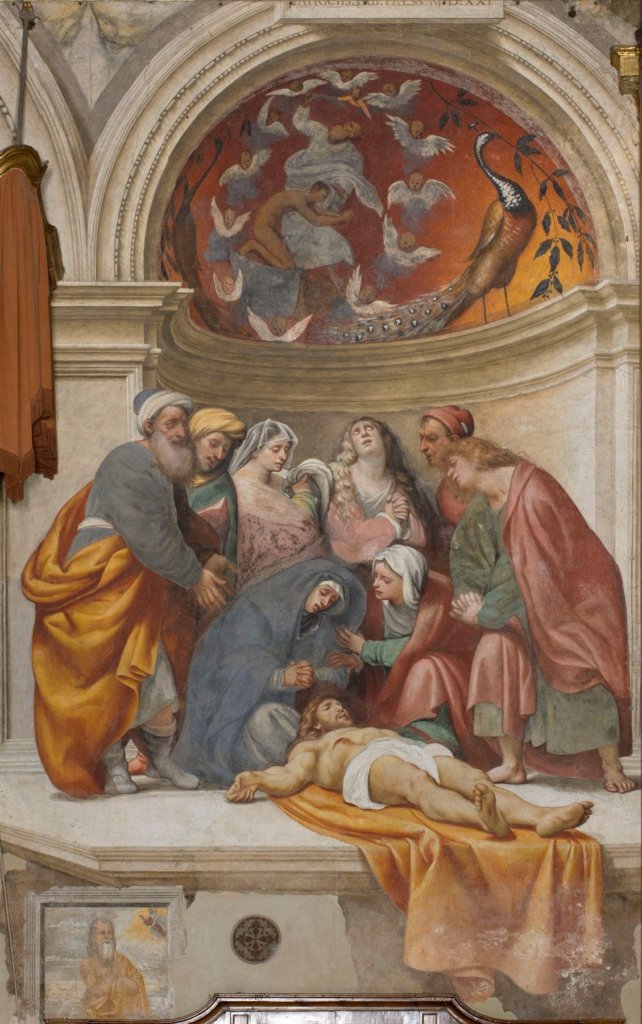Cathedral – Internal
Central nave
“HISTORIA SALUTIS”, “the History of Salvation”: the walls of the main nave from the apsidal basin to the counter-façade, in a succession of frescoed scenes, portray the main events of the life of the Virgin and of Jesus Christ. Our short journey inside the Duomo starts right here: from the central nave, whose pictorial decoration presents a catechetical efficacy of extraordinary value, to the point of being called “Biblia pauperum”, the “Bible of the poor”, which speaks indistinctly of the truths of faith to the hearts of all the faithful through the language of art and beauty. Already in the first two frescos that Boccaccio Boccaccino painted in the Cathedral in 1506-1507, the Pantocrator and the Annunciation, we find, in a perfect theological synthesis, the beginning and the end of the History of Salvation: from the Incarnation of Christ to his return in the fullness of time, glorious judge, portrayed in the effigy of the Pantocrator, resplendent in the His Majesty.
 The Annunciation (Boccaccio Boccaccino – 1507) Semi-dome arch above the apse
The Annunciation (Boccaccio Boccaccino – 1507) Semi-dome arch above the apse

A Majesty exalted by the “supernatural” tract of an neo-Byzantine-like representation that idealizes the human figure of our Lord by placing him on a dazzling golden background in the glory of the saints and in the fullness of his divinity, whom we likewise find present and exalted in the great Crucifixion of the counter-façade. We find the same Christ whom we have just seen on the throne of glory now on another throne: the gallows from which He, by sacrificing himself, redeems the whole of humanity. Humiliated to the point of death on the cross, He is the One, the Lord of Time and History, who will judge with mercy and righteousness. It is precisely the way of the cross the way through which we will obtain eternal salvation where we will meet him “just Judge” at the end of time. The powerful and immense size of these two subjects portrayed by Boccaccino in the Pantocrator and from Pordenone in the Christ on the cross, found at the frontally opposite ends of the Church, the apse basin and the counter-façade, seem to want to accentuate the greatness of this Mystery in the inseparable bond of the moments they portray, the supporting columns of everything we believe with sincere faith.
Turning our gaze towards the walls of the main nave we find the stories of the Virgin on the northern wall (at left upon entering) that tell the emblematic episodes of the life of the Madonna: from Joachim and Anna, parents of Mary, to her birth, to her marriage with Joseph – moments taken from the apocryphal Gospels – which then intersect, naturally, with the coming of Christ in the episodes of the Nativity and the first years of life of Jesus himself; works of the masters Boccaccio Boccaccino, Gian Francesco Bembo and Altobello Melone.
 Annunciation to Joachim | Meeting between Anna and Joachim at the Golden Gate (Boccaccio Boccaccino 1514)
Annunciation to Joachim | Meeting between Anna and Joachim at the Golden Gate (Boccaccio Boccaccino 1514)
First two frescoes of the cycle of the Life of the Virgin and of Jesus.
First span, north side, central nave
 Jesus on his way to Calvary (il Pordenone – 1520)
Jesus on his way to Calvary (il Pordenone – 1520)
Third span south side
On the southern wall, we find the stories of the Passion that, from the sanctuary area to the counter-façade, show the events that are conclude with Calvary: a succession of authors from Altobello Melone, to Romanino, to Pordenone – always chosen with the criterion of the best of the period, the first quarter of the sixteenth century – which tell the pain of One who, from the Last Supper, to the Condemnation, to the Cross, offers himself as sacrificial victim for all mankind.
The pathos of the composition of Pordenone in the last three bays which culminates in the great Crucifixion, is certainly the most effective way in its representation of these excruciating moments, thanks to an expressive unitive force, to the wise use of color, a virtuous stroke, Michelangelo-like, we could say, of extraordinary drama.
Next to the Deposition in the counter-façade the narrative cycle ends, – always by Pordenone – with the Resurrection: In fact, Christ did not experience the corruption of the tomb but “is truly risen and will return to judge the living and the dead”. The Resurrection is the work of Bernardino Gatti – the artist whose work we find again on the great altarpiece of the Assumption in the apse (unfinished in the low part due to the author’s death; in fact some figures of the apostles are missing) – flanked by two episodes: the centurion at the feet of Christ and the Entrance of Jesus in Jerusalem – works respectively by Antonio and Bernardino Campi, exponents of a family of exceptional Cremonese artists who, with Giulio Campi, we will find again in many other works inside the Cathedral.
Crossing the mighty arches of the main nave, we find the side aisles and transects, whose their wealth of altars preserve priceless works, in fact, by Campi, as mentioned, but also from Genovesino, from Malosso and from many others, also present in the two side chapels of the Blessed Sacrament and the Madonna of the Peoples; caskets that, between baroque stuccos and gold, reveal moving beauty.
 Altarpiece of the Assumption
Altarpiece of the Assumption
(Bernardino Gatti, who died before finishing the work. It was completed in 1579 by Giovanni Battista Trotti, alias Malosso)
Duomo Exterior





